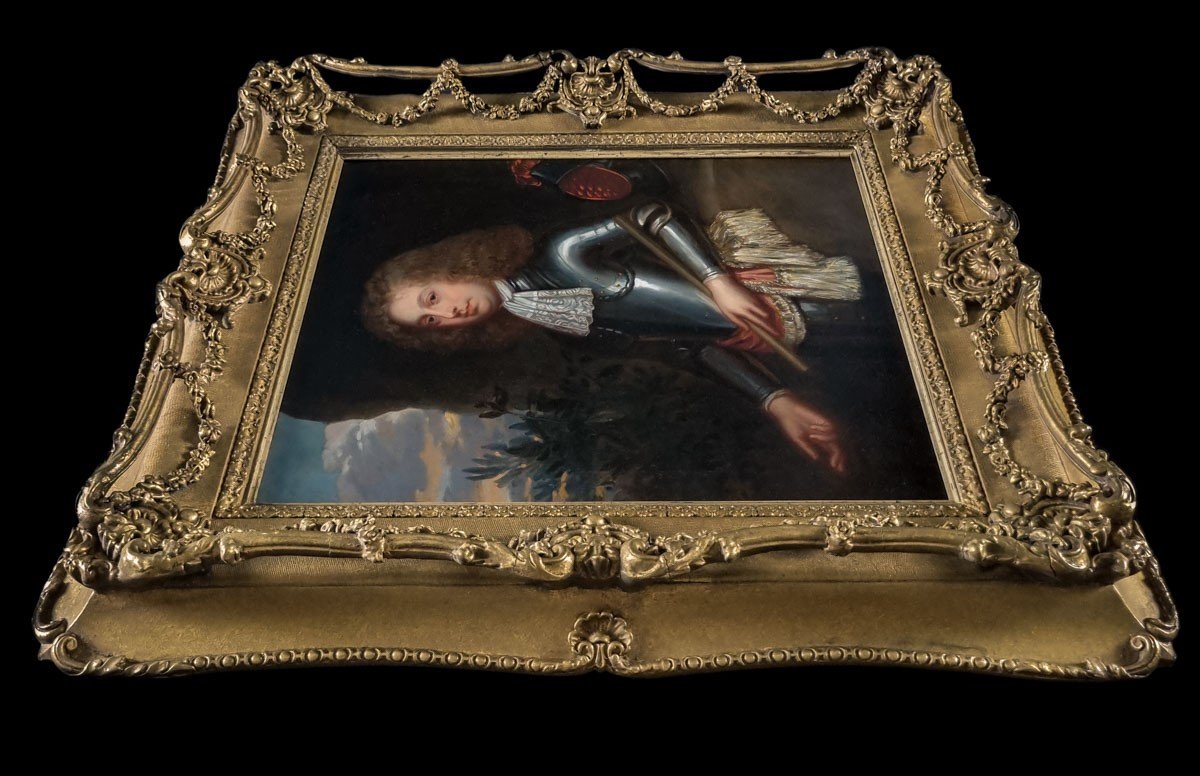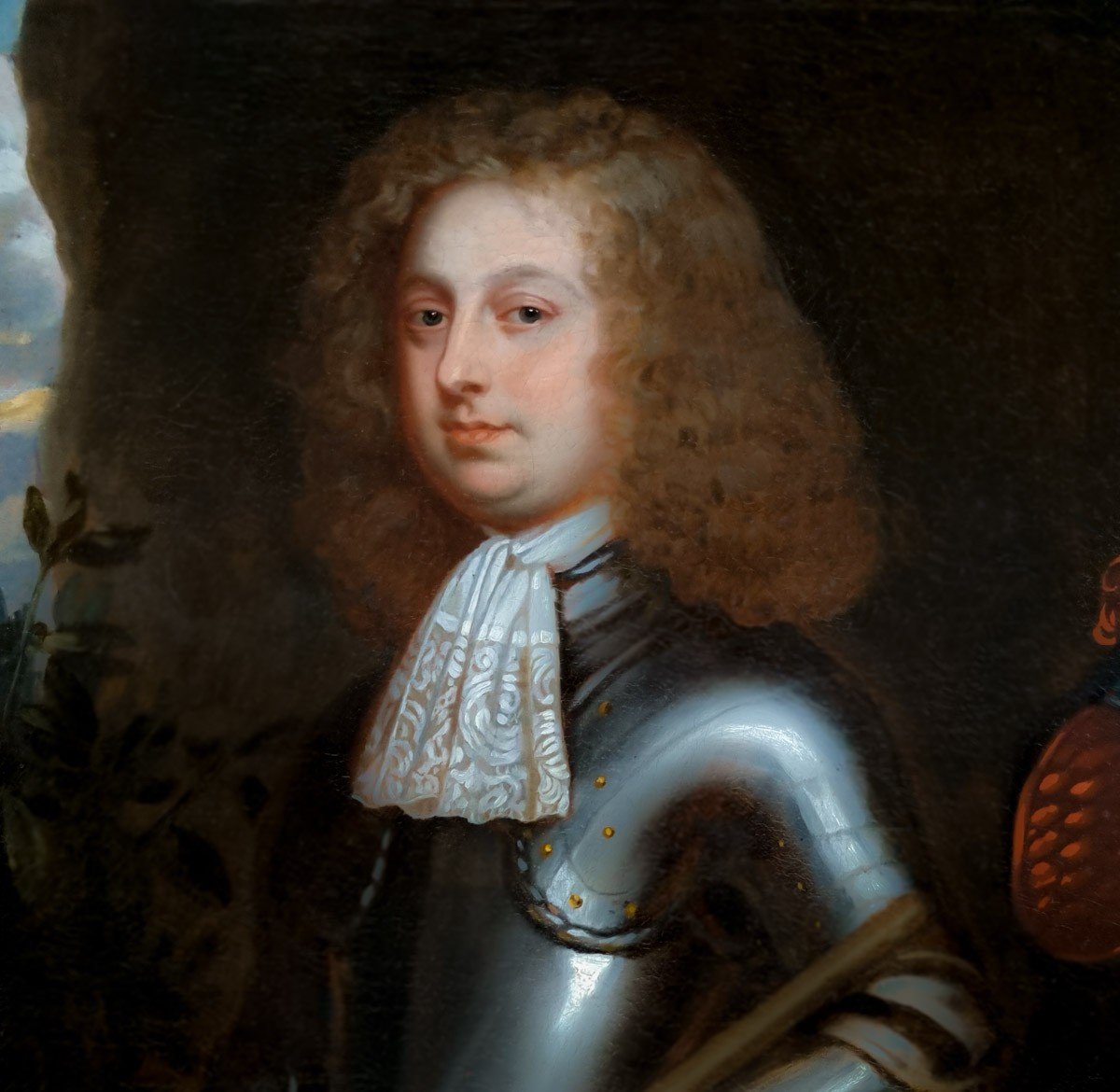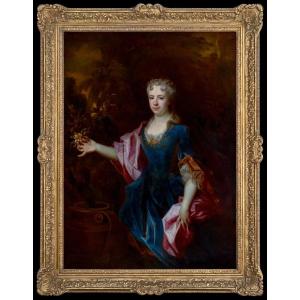Studio of Willem Wissing (c.1656–1687)
Depicted standing on a rocky outcrop wearing suit of armour over a white cravat, the gentleman is shown with such symbols of power and office - the plumed helmut, the armour, and the baton of command is a symbol of military authority, for the sitter held many senior positions within the military. The sumptuous red sash, fringed with gold, is striking. His heroic visage suitably reflects his wealth and status and this martial-like characterisation was popular at the time. This painting is evidence of the commensurate skill of the artist. The extremely finely recorded face, painted with the utmost precision, are an exemplary artistic achievement and show the artist’s Dutch training. Slightly unusual for portraits at this time, the sitter appears to wear his own natural hair, and not a wig.
A feature of this portrait is its exquisite and unusual frame, with swags of flowers suspended across all four sides. The frame is highly unusual, very rare, and a work of art in itself.
The gentleman in Richard Knight (1639-1679) and he was a member of a family who were long established in the county having held lands there from the time of Edward II, if not earlier. Richard was the only son of Richard Knight of Chawton (died 1641/42) and Elizabeth Fielder. His father died when he was only two years of age and the young Richard’s mother, Elizabeth, managed his property until 1649, when she married Azariah Husbands of Hocksley Hall, Essex. One must wonder if she and her young son were looking out on the 20th of December 1648 when Charles I passed by, guarded by a strong body of troops, on his last journey from Hurst Castle to Windsor.
On the 10th January 1667 Richard received the honour of Knighthood of the Royal Oak, soon after his marriage to Priscilla, sole daughter and heiress of Sir Robert Reynolds of Elvetham. Sir Richard was said to be an honourable man with polished manners and a distinct love for this country. He was highly cultured and a patron of the arts. In 1679 when he was 40 years old, he strove for the parliamentary representation of his country but died before the election was completed. He left no children and the estate passed to another line of the family (it should be premised that every successive owner took the name of Knight). Sir Richard Knight left £500 for his monument to be built in Chawton Church where it stands today in the Chancel (see photo).
An inventory taken on the death of Sir Richard at Chawton on 16th day of Sept 1679, by Mr Thomas Townsend, William Fisher, Thomas Mathew, and Edward Fisher states: “In the passage at the parlour staircase head: Item one chimed clock & case, three pictures where of one large & two small ones”. Perhaps our portrait was one of the mentioned. Many family portraits remain to this day at Chawton.
The family’s seat is Chawton House near Farnham England. Although an earlier house was on the site, the descendants of Hugh de Port, William the Conqueror’s comrade in arms, lived at Chawton for nearly 500 years, before the house fell by default of a male heir, to their distant relatives in 1458. By this family the property was sold in 1551 to John Knight and from that time forward the estate and manor passed within the Knight family. The existing manor, which is a beautiful Tudor structure, was built by John Knight (our sitter’s grandfather). One of his descendants was Elizabeth Knight, whose progresses were marked by the ringing of church bells and whose two husbands both had to adopt her surname.
The date of 1593 can be seen over the door of the extremely quaint old stables. The earlier date of 1588 remains at the back of the fireplace in the hall. It was a memorable year in English history, being that of the great Armada, with which John Knight contributed £50 to the fund raised by Elizabeth I to resist the attempt of the Spaniards. Later in the 18th century Jane Austen's brother Edward (who had been adopted by the Knights) inherited the estate in 1794, and in 1809 was able to move his mother and sisters to a cottage in the village, now Jane Austen's House. The Knight family lived at Chawton until 1987 and the current member of the family, the great, great, great grandson of Jane Austen’s brother Edward, retain the freehold. The house is now Chawton House Library, one of the world’s leading centres for the studies of the lives and works of writing in English between 1600 to 1830; the house itself is interwoven with the family story of perhaps the most famous women writers, Jane Austen (1775-1817). The house still contains the collection of Knight family portraits, one almost exactly like ours.
During this period, artists, on this scale, painted both original compositions and copies of portraits that were given to friends and relatives of the sitter or for their smaller London homes. Our portrait, painted by Willem Wissing and his studio, is probably a prototype for a much larger portrait that is either lost or not yet recognised, and the most likely date of its execution was the period between Wissing’s arrival in England in 1676 and the death of the sitter in 1679. An almost exact version of our portrait (127 x 101.5cm) is in the Knight collection at Chawton House, and even though it is much larger in scale it does not appear to be a prime version.
William (Willem) Wissing was a Dutch artist who enjoyed a solid artistic training at The Hague under Arnold van Ravesteyn (c.1650-1690) and Willem Dougijns (1630-1697). He came to London in 1676 and most probably joined the studio or Sir Peter Lely as an assistant that same year. After Lely’s death in 1680 he effectively took over his business and he scaled the heights of patronage with extraordinary ease, creating an independent practise in 1687, and painted for very important aristocratic patrons. King Charles II was so impressed by a portrait Wissing painted of his son, the Duke of Monmouth, in 1683 that he commissioned his own portrait and that of his Queen Catherine of Braganza. His polished elegance, luscious detail and atmospheric power ensured his meteoric rise from studio assistant in 1680 to royal painter in all but name in 1683.
The painter’s last great patrons were John Cecil 5th Earl of Exeter and his Cecil and Brownlow relatives in Lincolnshire before his career was to be abruptly cut short with his early demise in 1687, aged just 31, giving rise to the sort of romantic apocrypha that attach themselves to genius. At that time, he was staying at the Earl’s seat Burghley House, engaged on his most ambitious work, a vast canvas showing the Earl and his five grandsons at full length. John Vandervaart (whom Wissing collaborated with) took over Wissing’s studio.
Literature:
Country Life XIII, p. 874, 1903
Country Life XCVII, p. 200, 244, 1945
Measurements:
Height 71cm, Width 64cm, Depth 9cm framed (Height 28”, Width 25”, Depth 3.5” framed)
£ 8,650
€ 9,250 (EU market only)
$ 9,750 (US market only)

























 Le Magazine de PROANTIC
Le Magazine de PROANTIC TRÉSORS Magazine
TRÉSORS Magazine Rivista Artiquariato
Rivista Artiquariato
